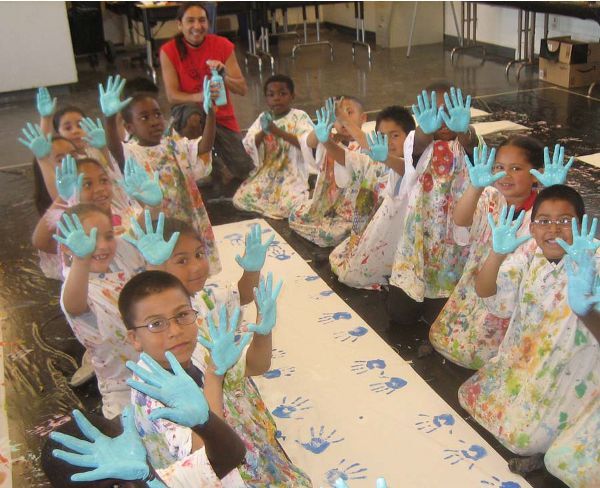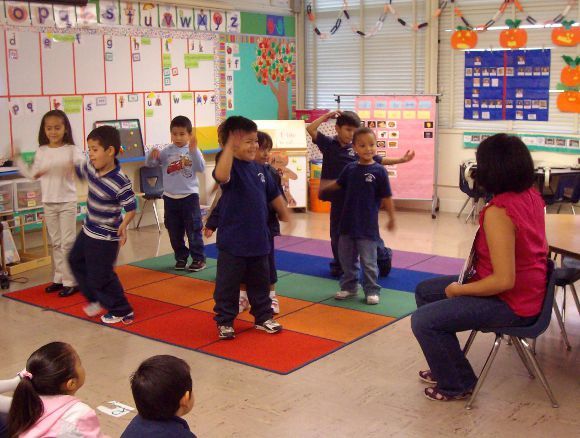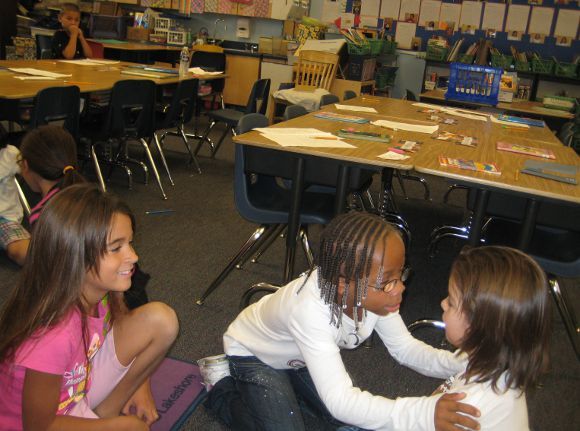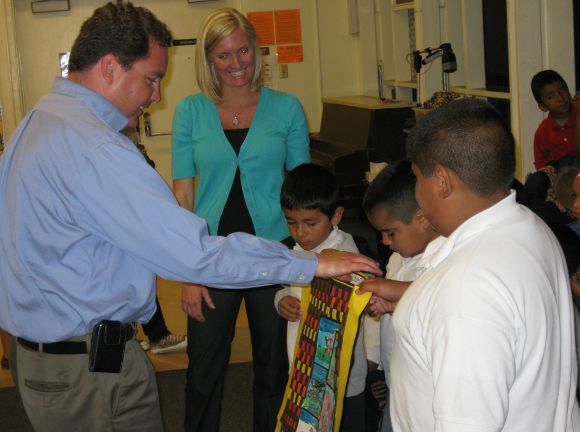Stages of Learning: Theater and Language in San Diego Schools

In partnership with BoomMagazine: Boom: A Journal of California is a new, cross-disciplinary publication that explores the history, culture, arts, politics, and society of California.
Known for its sunny beaches and mild Mediterranean climate, its tourist attractions and international conventions, San Diego is a popular travel destination. Yet this cultured and cosmopolitan city has another face, which is little known to outsiders. East of downtown and south of the Martin Luther King Jr. Freeway lies the area locals call "the Southeast." Through the last three decades, it has been plagued by gang violence, homicide, and poverty. In fact, its reputation was so bad back in 1992 that Councilman George Stevens campaigned against any official use of the designation "Southeast San Diego," pointing to the term's perceived negative connotations.
Yet something significant has been happening in the elementary schools in this part of the city. While schools in the coastal and northern areas of San Diego have usually scored well, now innovative programs have begun to energize schools in neighborhoods that were once left behind. This includes the Southeast, a diverse area with nearly 90 percent of the population distributed among Latino, Filipino/Southeast Asian, and African American groups. In state tests for the 2009-2010 school year, San Diego ranked first among California's seven large urban districts in language arts and science, and third in mathematics. One factor leading to these advances was an intriguing, grant-funded program that draws on the arts to teach literacy in schools where budget constraints limit options and art programs have long been absent.1 The power of the arts, not only to help with language learning but to encourage children from diverse backgrounds to bond during creative activities, has been striking. But the mechanisms through which arts integration works are still not widely understood.
Transcending Language Barriers in the Classroom
A moment during a theater arts lesson captures the role of imagination in helping children connect to new vocabulary. As a kindergarten teacher in southeastern San Diego gazes around the circle of sixteen children who stand facing her, they keep their feet together and arms at their sides. "Actors," she says quietly, "touch your nose if you're ready." Giggling, each child does so. "Let's act like we're so cold that we are shaking. Brrrrrrr." Children shiver dramatically. "If we were hot, what would it look like?" They mime wiping sweat from their foreheads. "What if you were reading a book?" Each child turns the pages of an unseen book.

Glancing around the circle, the teacher can immediately see when a child needs assistance. When the school year began, few of these children knew more than a few words in English. Three months into the school year, some still glance quickly at their peers before responding. Yet, the light-hearted mood is unmistakable. The motions that accompany the teacher's words enable the children to follow along easily. "Now, I want you to use your first grade voice, even though you're still in kindergarten..."
Although these theater arts activities may seem like play, they have a serious curricular intent. Theater activities, along with music, dance, and visual arts, provide a powerful medium for experiencing and communicating. A dozen teachers interviewed about their experiences affirmed some of the gains they witnessed students acquire. In September, most of the children barely spoke above a whisper during theater lessons. Now, as winter break approaches, they step forward and introduce themselves with confidence. In describing the impact of the theater arts lessons, their teacher emphasizes the enhanced sense of camaraderie, teamwork, and motivation she sees in her class this year.
Another teacher describes how two very shy students blossomed during theater lessons, "broadening their vocabulary and. . . just showing a lot more confidence. [They] ... participat[ed] more throughout the day, not just during theater but through our shared reading or during math." Discussing how a fairy tale character's feelings piqued interest and also boosted language acquisition, a third teacher observed, "I've compared my kids this year, right now in November and early December, to where they usually are in April or May. The quality of talk that I'm getting from the students right now is just amazing. The kids are just opening up. I didn't see that until the spring [in previous years], and I'm seeing it now."

A dance lesson builds upon prior learning experiences through music and movement, echoing the processes that children go through when first learning to communicate. Mirroring their teacher's motions, children experiment with new vocabulary words: they "ascend" as they mime, growing like a flower or flying like a bird; they "descend" by pretending to sink under water or melt like ice. Physical and sound cues (syllables and rhythms) allow children to use their bodies to grasp meaning and understand verbal instructions. In visual art lessons, children draw and organize representations of their evolving mental models of the world, coming to terms with fears and desires in a safe space, before describing the content of their pictures to peers.
Research shows that if ELLs (English Language Learners) are to learn English fast enough to succeed in school, practice with oral language is critical. Regrettably, in many urban classrooms, the opportunities for one-on-one verbal interaction between teacher and pupil are limited by rising class sizes and a highly structured curriculum. Performing arts activities allow a teacher to interact with many children at once. Arts integration is especially effective at the onset of students' learning a new language--when children understand more words than they can produce. Given the chance, children will exhibit gestures, behaviors, and nonverbal responses that indicate understanding of what they've heard. Performing arts activities allow children to build vocabulary in a manner that grows naturally out of their nonverbal responses.
Bringing the Arts Back to School
The collapse of arts education funding in California has, unfortunately, made scenes like the ones just described exceedingly rare. A 2007 study by SRI International found that 90 percent of California elementary schools fail to provide a standards-aligned course of study across all four arts disciplines--visual art, music, theater, and dance--with theater and dance most often skipped.2 Although the recent fiscal crisis has resulted in still more cuts to arts education, collaboration between teaching artists and school districts may help to bring the arts back.
The K-2 Teaching Artist Project (TAP), a collaboration between the San Diego Unified School District and the University of California, Irvine, uses arts integration to boost the literacy skills and social-emotional development of children in fifteen high-poverty area schools with large numbers of ELLs.3 During their first year in the program, teachers co-teach twenty-seven weekly arts-and-literacy lessons (divided equally among theater, dance, and visual art) with teaching artists employed by the San Diego Visual and Performing Arts Department (VAPA). In their second year in the program, classroom teachers implement the same lessons on their own with support from VAPA resource teachers.

The goal of the program is for teachers to become comfortable using arts-based strategies to provide multimodal learning opportunities in all content areas. The Teaching Artist Project was a product of serendipity. San Diego city schools have a proud history of excellence in the arts; dedicated professionals continue to show how much can be accomplished through targeted assistance, with minimal investment in supplies. Visual and Performing Arts Director Karen Childress-Evans and resource teacher Denise Lynne believed strongly--based on their own experiences--that the arts could be a powerful resource for preparing K-2 teachers to expand the oral language skills of ELLs. In 2007, they shared their ideas with one of the authors, a researcher with the UC Irvine Center for Learning through the Arts, Sciences and Sustainability (CLASS).
Originally called "The daVinci Center," CLASS was first set up to serve the network, UC ArtsBridge which sends advanced arts students to co-teach with classroom teachers in arts-poor public schools. The Center's mission was broadened after the demand for ArtsBridge residencies waned following passage of the No Child Left Behind legislation of 2001, with its single-minded focus on literacy and math. Urban schools, under pressure to raise standardized test scores, became hesitant to "waste" time on the arts. This hesitancy, along with budgetary constraints, gradually eliminated standards-based arts instruction from most urban schools in low-income neighborhoods. Ironically, recent research indicates that well-designed arts integration actually boosts student achievement in language arts.
Implications for the Future
For the San Diego and UC Irvine partners, the opportunity to reinvigorate arts in the curriculum and to show that arts-based strategies can boost the achievement of ELLs was exciting. Soon a grant proposal was in the works. From a policy perspective, however, the salient characteristic of the K-2 Teaching Artist Project partnership was the active involvement of both school and university personnel. The University of California has a tradition of public scholarship; but, in recent years, the definition of "research" has narrowed. Faculty have, therefore, channeled their efforts toward writing for academic journals, leaving limited time for meaningful engagement in public problem-solving that broadened the scope of their efforts.
Yet, in times of diminished resources, the university is one of the few institutions that still has assets to invest in addressing state-wide problems. Numerous faculty would undoubtedly lend their talents to public initiatives if university policy enabled them to do so without sacrificing other important career goals. Perhaps the time has come to make productive public engagement a more prominent component of the mission of California's public universities.

In San Diego, a border city where 30.2 percent of students are English Learners and 59 percent receive free or reduced price meals, finding effective ways of educating ELLs is an urgent priority. And San Diego is not alone. In recent decades, the United States has experienced a dramatic increase in children entering school whose home language is not English. Presently, this population comprises 10 percent of all students, or five million, of whom nearly one-third are in California.4 This is a young population: According to the California Department of Education, ELLs comprise 25 percent of the state's kindergartners. In a time of budgetary austerity, there is a tendency to react to such statistics with a sense of numbness. However, children now in kindergarten cannot wait until the economy rebounds.
The need to educate California's future workforce compels more than reflection. The Teaching Artist Project powerfully demonstrates that hope and resilience can be stimulated by the arts, some institutional collaboration, and a modest injection of outside funding.
Notes:
1Made possible by an Improving Teacher Quality (ITQ) grant administered by the California Department of Education.
2The report can be found at the Stanford Research Institute link at http://policyweb.sri.com/cep/projects/displayProject.jsp?Nick=artsed.
3Streaming videos, lesson plans, and other materials created for the K-2 Teaching Artist Project theater and curriculum are available, free-of-charge, on the website of the UC Irvine Center for Learning in the Arts, Sciences, and Sustainability, at: http://www.class.uci.edu/theatre-grades and http://www.class.uci.edu/dance-grades. To view the videos and lesson plans, click on a grade level, and then on a specific lesson.
4Made possible by an Improving Teacher Quality (ITQ) grant administered by the California Department of Education.
Dig this story? Sign up for our newsletter to get unique arts & culture stories and videos from across Southern California in your inbox. Also, follow Artbound on Facebook, Twitter, and Youtube.


